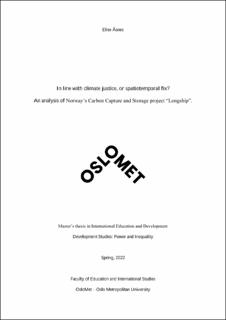| dc.contributor.advisor | Svarstad, Hanne | |
| dc.contributor.author | Åsnes, Elise | |
| dc.date.accessioned | 2022-08-17T08:43:14Z | |
| dc.date.available | 2022-08-17T08:43:14Z | |
| dc.date.issued | 2022 | |
| dc.identifier.uri | https://hdl.handle.net/11250/3012277 | |
| dc.description.abstract | This thesis aims to identify the Solberg government's narratives surrounding Longship and connect this portrayal to two theoretical frameworks to consider Norway's responsibility: climate justice and spatiotemporal fix. This thesis points to how the Solberg government portrayed Longship as a project that would ensure that Norway cost-effectively achieved the climate targets while securing continued economic growth. The Solberg government also applied CCS to legitimize continued oil and gas extraction. Moreover, Longship can be a vital contribution to reducing greenhouse gas emissions as CCS plays a central role in the climate targets and could prove to be a climate mitigation initiative that does not impose unjust burdens on the global South compared to other climate measures. However, Longship also has tendencies that can be viewed as a spatiotemporal fix: maintaining the status quo and downplaying the negative effects and uncertainties. Longship could also have negative consequences if it is not as successful as it is portrayed. Based on this, this thesis argues that Longship is a vital climate initiative. However, Longship's problematic parts are related to the Solberg government's application of the project in their narrative to continue oil and gas extraction, ensuring continued economic growth and downplaying the technological uncertainties. | en_US |
| dc.language.iso | eng | en_US |
| dc.publisher | OsloMet - Storbyuniversitetet | en_US |
| dc.subject | Carbon capture | en_US |
| dc.subject | Carbon storage | en_US |
| dc.subject | CCS | en_US |
| dc.subject | Climate justice | en_US |
| dc.subject | Spatiotemporal fix | en_US |
| dc.subject | Norway | en_US |
| dc.subject | Petroleum industry | en_US |
| dc.title | In line with climate justice, or spatiotemporal fix? An analysis of Norway’s Carbon Capture and Storage project “Longship” | en_US |
| dc.type | Master thesis | en_US |
| dc.description.version | publishedVersion | en_US |
| dc.source.pagenumber | 103 | en_US |
| dc.subject.nsi | VDP::Samfunnsvitenskap: 200::Statsvitenskap og organisasjonsteori: 240 | en_US |
| dc.subject.nsi | VDP::Samfunnsvitenskap: 200::Sosialt arbeid: 360 | en_US |
